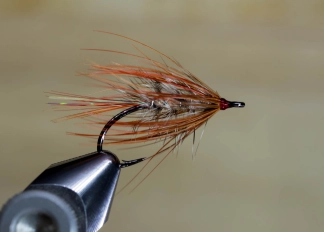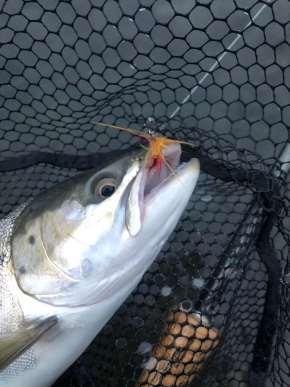A great looking and very catchy Danish sea trout fly, useful all year round in spite of the name.
This fly is a Danish sea trout fly, tied to catch sea run brown trout along the Danish and Baltic coasts. It was originated by Danish fly angler and tyer Henrik Brangstrup in the late 90’s, and even though it’s not one of the best known or most popular flies, it has a long history, and gets attention and is regularly tied and used – and seen in magazines, in books and on the small Danish part of the almighty internet.
The name
doesn’t actually mean that it’s a fly meant for the autumn, as it might imply. The name comes from the colors and the fact that the originator dropped a fly during one autumn trip, and had a very hard time finding it again on the ground among the fallen autumn leaves.
So don’t be afraid to tie and use it all year round. Its size and volume actually says “spring” more than “autumn” in my eyes – and even “clear summer day” – although I wouldn’t hesitate to fish it in September or October.
The original aim
was to tie a fly in not too bright colors, and the dull gray body covered by the golden pheasant hackle does give the fly the perfect dull hues that a lot of sea trout anglers prefer over shiny and colorful flies.
The original has a little flash in the tail and has a shiny silver rib, but for even more stealth you can leave out the flash and use a dull or almost invisible rib like mono or copper wire.
Also, the original recipe lists cat or muskrat wool as the body dubbing. For those of us who don’t have a pet cat (or muskrat) in a suitable color, most types of dull tan or gray dubbing can be used. Hare, rabbit, squirrel or most other natural dubbing, and of course a host of synthetic types in the proper hues. Just make sure you use a dubbing that doesn’t repel water, because this fly is a slow sinker as it is with its light hook and generous hackles, and adding dry fly dubbing will almost make it float – or at least sink really, really slowly… like really.
|
|
|
|
|
|
|
|
|
|
|
|
Apart from those notes,
tying the fly is pretty straightforward. The tail is GP, the body hackle is palmered and secured with the rib and the front hackle is also GP, selected and tied in to sweep over the body in its full length and a bit, the tips almost reaching the tip of the tail, and giving the fly a lot of movement in the water.
You can of course
consider different variations of the fly, and the one most commonly seen here is a lighter body, typically a cream or very light tan color. You can also consider a colored body, like on the Atumn Flies tied by Danish Allan Overgaard, shown here. You can work with the front hackle, and replace it with another long, sweeping feather like teal, mallard or merganser. But then your fly will then have strayed pretty far away from the original, where it’s exactly the dull colors of the dubbing and hackle that gives it its character.
Fishing the fly
isn’t rocket science. Like most generously hackled, unweighted sea trout flies it sinks slowly, and giving it time to sink a bit after it’s landed is a good idea.
This not only lets the fly find a bit of depth, but the first tug also sometimes provokes some immediate and pretty violent strikes from fish, which might have been attracted by the fly landing in the water.
If the fly is presented at the end of a properly stretched leader, it will make a very small splash, which seems to me to often attract the interest of fish. But I have rarely experience the fish taking the fly right after it has landed and is sinking slowly. But the smallest movement brings further attention to the fly, and a strike right after the first pull on the line isn’t rare.
If nothing happens, try stripping a meter or two (3-6’) and then leave the fly hovering for a few seconds. Continue the stripping with a couple of brisk pulls, and then continue in a steady pace. These variations can sometimes trigger strikes from fish, which might be around, but haven’t been tempted.
Martin Joergensen
Martin Joergensen
- Log in to post comments






























Gratis!!!
@Martin & Allan
An excellent article! ... as a whole. The pictures contribute very well to the atmosphere (I felt the taste of the sea water in my mouth and the smell of the freshly applied headcement), and the elegance of these presented flies, just embellish the overall impression. From my point of view, it is the best article written by you guys. Thank you !!! ... you made my eyes happy and you made my soul as a fly fisherman to sing and dance.